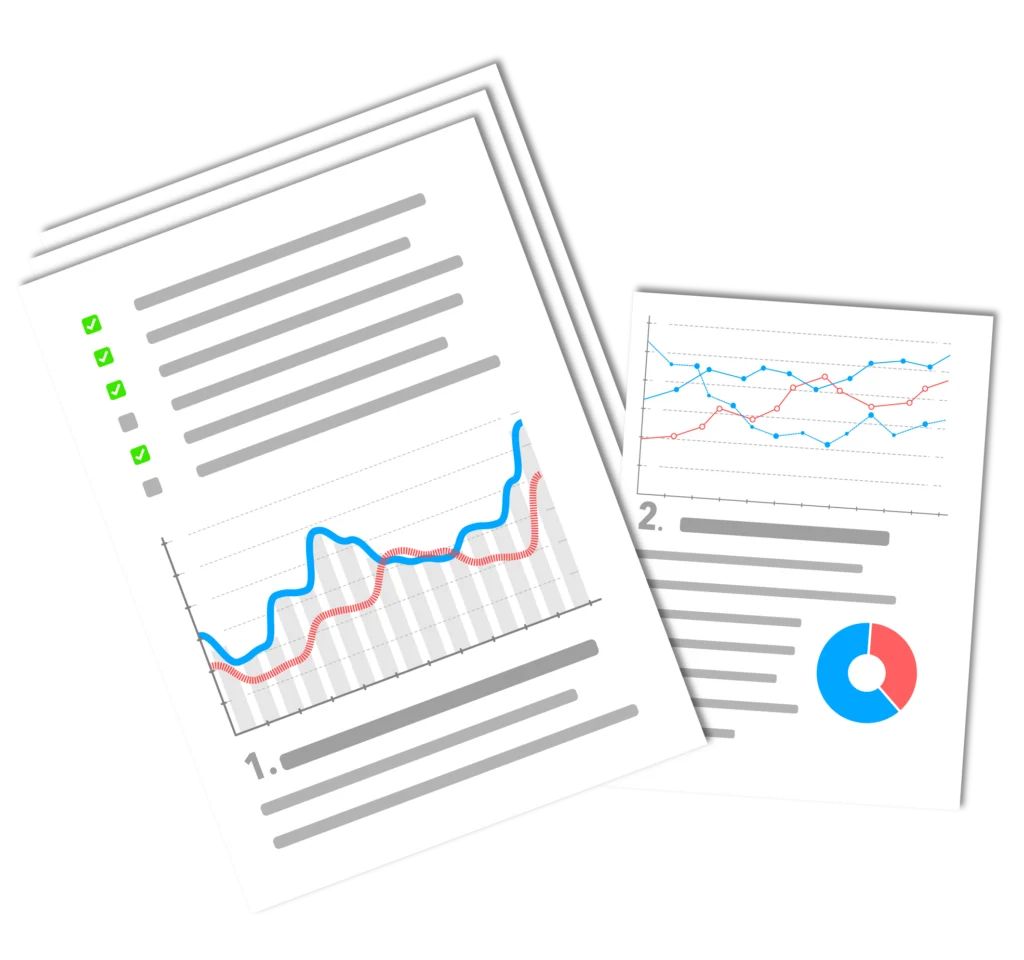An important element of on-page SEO is the Content-SEO. In short, it is about Content-SEO is about creating and optimizing your content so that it ranks high in search engines and gets search engine rankings.Traffic can attract.
In this article you will find out what Content-SEO and how to optimize your content for search engines and users using best practices.
To understand what we mean by SEO content, you first need to be clear about what the main purpose of SEO is, what types of content there are and what content optimization is.
What is SEO?
Suchmaschinenoptimierung oder SEO ist der Prozess der Optimierung deiner Website, um die größtmögliche Sichtbarkeit in Suchmaschinen zu erreichen.
The SEO process includes a number of steps, which are usually divided into the following groups: technical SEO, On-page SEO and off-page SEO (e.g. Linkbuilding).
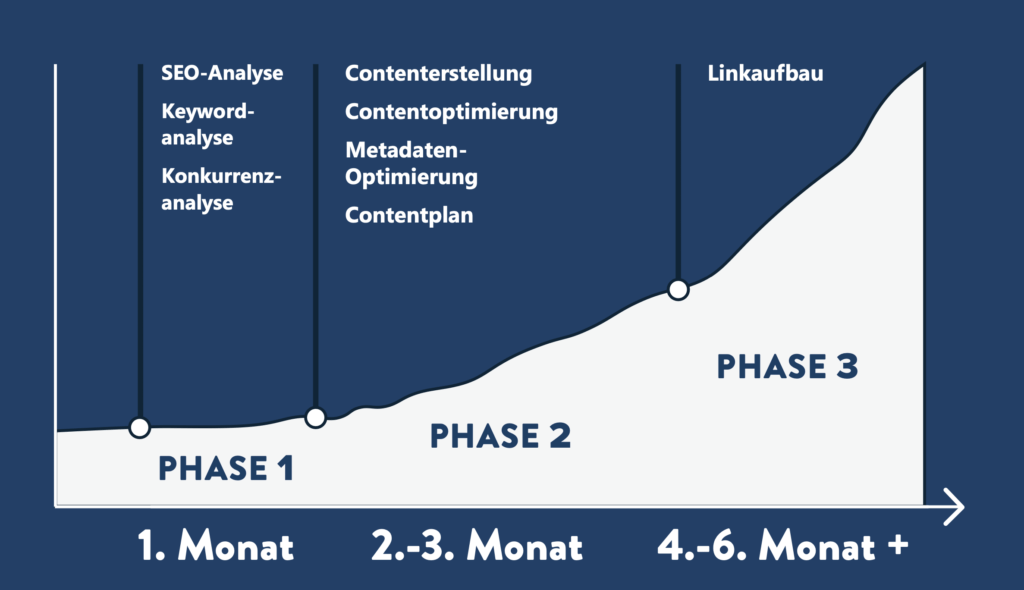
Content SEO is part of on-page SEO.
It starts with On-page SEO, with the optimization of the Page title and the H1 headline, and then it's about the content of the page.
Your overall goal with the Content SEO it is, SEO friendly content to write in such a way that they are understood by search engines, but at the same time the Search Intentions of the users and satisfy them.
What are the types of SEO content?
Before we get into how you can optimize your content, let's look at what we mean by content.
Content can have different forms. It can be Text, Images, Videos, Audio, Infographics or a combination thereof.
In general, there are the following types of content:
Blog Posts: The most widely used format. It can be a Combination of text, images and videos be. It can be news format articles, lists, guides, press releases or general information.
Static pages: Content that can be found on static pages of your website, such as the "About us" page.
Product pages & cateory pages: Pages that advertise certain products or services. (these pages are often very after the customer's purchase and therefore especially important).
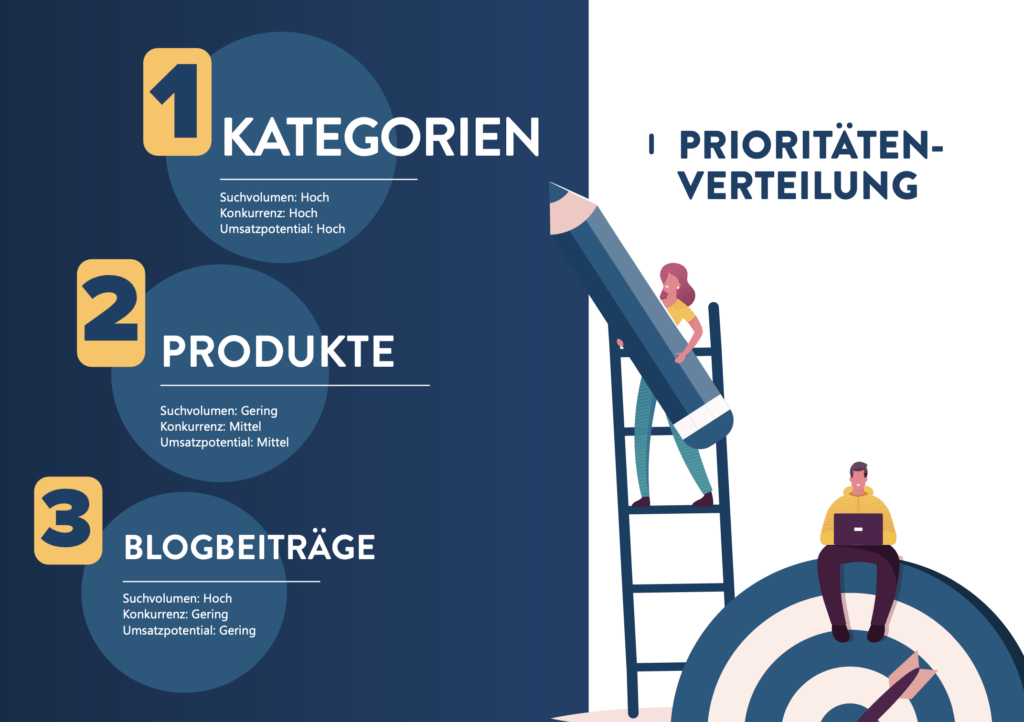
Landing Pages: Pages that are specifically designed for PPC campaigns or are the first page users see when they visit your website.
1. content optimization starts with keyword research
Before you get your hands dirty and start thinking about your introduction, you first need to get your Homework make and by this we mean the Keyword research. For this we recommend tools like Semrush, Ahrefs or KW Finder.
If you know what keywords users are typing into the search box, you can do two things:
- You know what kind of content to create to keep users happy
- You know how to optimize your content to increase your chances of being noticed by search engines. In the long run, that means higher rankings and more visitors.
The result of your keyword research should include three things:
- A decision, which is the Main keyword is what you are aiming at
- A Set of long tail keywordsrelated to your main keyword
- A series of LSI keywordsthat are related to your main keyword (more on this below).
You'll use these as part of the content SEO process. To be more precise:
- Your Target-Keyword should be in the URL, the Page title and the h1 headline be included.
- Long-tail keywords can be included in your Subheadings be included
- Other vrelated keywords (LSI) can be used in your Subheadings and in the Main part of the content must be included.
2. use keywords in the title, headline and body of your content
Everyone knows that your Main keyword in title and h1 heading should appear, but it is just as important to keep your Keyword once or twice in the first two paragraphs to mention.
There is a rule of thumb that states that the most important content of a page is the one that is in the upper part of the page (above the fold) located. So make sure you give the search engine spiders within that content more clues as to what the rest of the content is about.
When you point to a specific Keyword you are not just repeating it over and over again, but you are use variations of this keyword in your content.
A good way to do this is, Long-tail keywords that are related to your main keyword, and to find these in your subheadings to use.
Type your main keyword into the Google search box and watch for the different suggestions. These are great keywords to include in your subheadings and content.
3. always accompany your non-text content with text
Search engines can understand text content better than any other type of content. So make their lives easier by having text content on your site, even if you are promoting other types of content.
For example, let's say you have a beautiful Infographic on a topic and would like to publish it on your blog. Don't just insert the infographic and press "Publish", but try to have text content on the page that explains what the infographic is about.
You can apply the same concept when you publish images, videos or audio posts. For example, if you offer a podcast, you can include the podcast description and even a text transcript to help both users and search engines understand what the audio is about. Alternatively, a well-formatted transcript can also help here.
4. fulfill the user's intention and make it clear from the beginning
Before you publish any content on your website, you need to understand user intent. In other words, what kind of content users want to see for a particular search query.
The easiest way to do this is to take advantage of Google, because they (Google) have already done a great job of understanding what users like in different searches.
Here are the steps you need to follow:
Let's assume you are writing an article about "Ahrefs test". The first step is to search for this term on Google and look for the Featured Snippet und den Meta-Beschreibungen der ersten 10 Ergebnisse zu suchen.
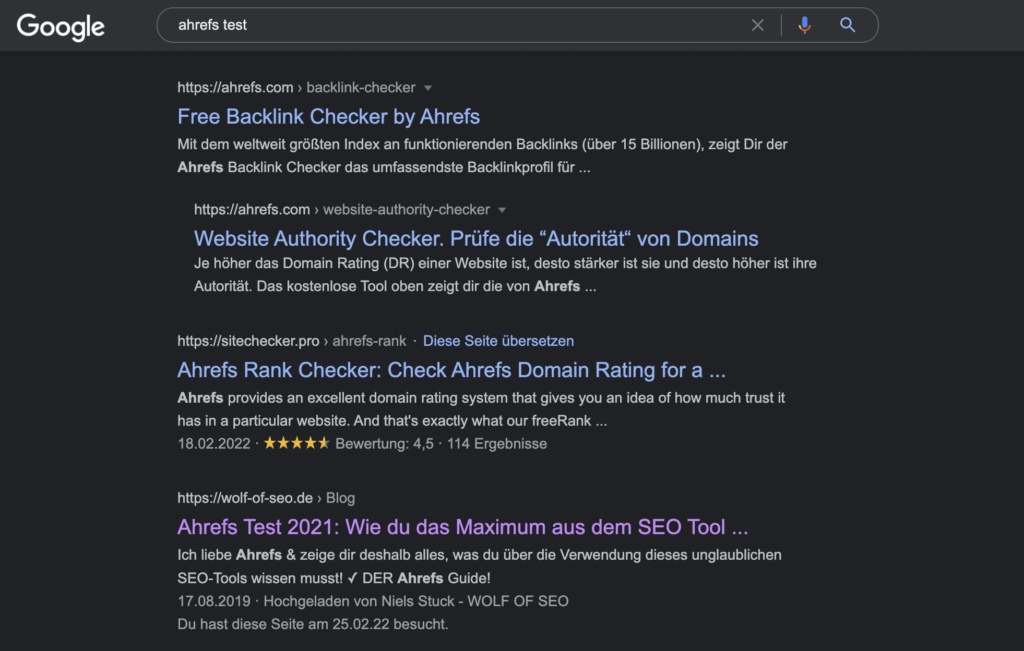
Examples of keywords and their search intentions:
| Longtail-Keyword | Search Intention | Content type |
|---|---|---|
| "Rain jacket for women" | Purchase: of rain jackets for women | Product page |
| "Yoga exercises for beginners" | Informative: examples of yoga exercises for beginners | Instructions/Videos |
| "Plant care in winter" | Informative: about plant care in winter | Advisor/Blog Post |
| "Comparison of credit cards with cashback" | Transactional: comparison of credit cards with cashback options and links to the providers | Comparison table/blog post |
| "Nutrition plan for losing weight with a vegetarian diet" | Informative: diet plan to lose weight with vegetarian diet | PDF Download/Blog Post |
| "Destinations for a family vacation" | Informative: article about destinations for a family vacation | Travel Guide/Blog Post |
| "Fitness studios with personal training" | Transactional: search for gyms with personal training options | List with studios/locations |
| "Ski resorts for beginners in Austria" | Informative: Ski resorts for beginners in Austria | Travel Guide/Blog Post |
| "Job search for career changers in the IT sector" | Informative: Job search for career changers in the IT sector | Job market/guide |
| "Rattan garden furniture" | Purchase: of garden furniture from rattan | Product page |
| "Car repair in Vienna" | Transactional: Search for garages in Vienna | List with workshops/locations |
| "Financial planning for the self-employed" | Informative: about financial planning for the self-employed including links to options. | Advisor/Blog Post |
| "Comparison of fitness trackers with GPS" | Transactional: comparison of fitness trackers with GPS function with links to purchase. | Comparison table/blog post |
| "Nutrition plan for vegan muscle building" | Infotmatic:Nutrition plan for vegan muscle building | PDF Download/Blog Post |
5. write content in long form
There are a number of studies that show long-form content performs better in search and on social networks.
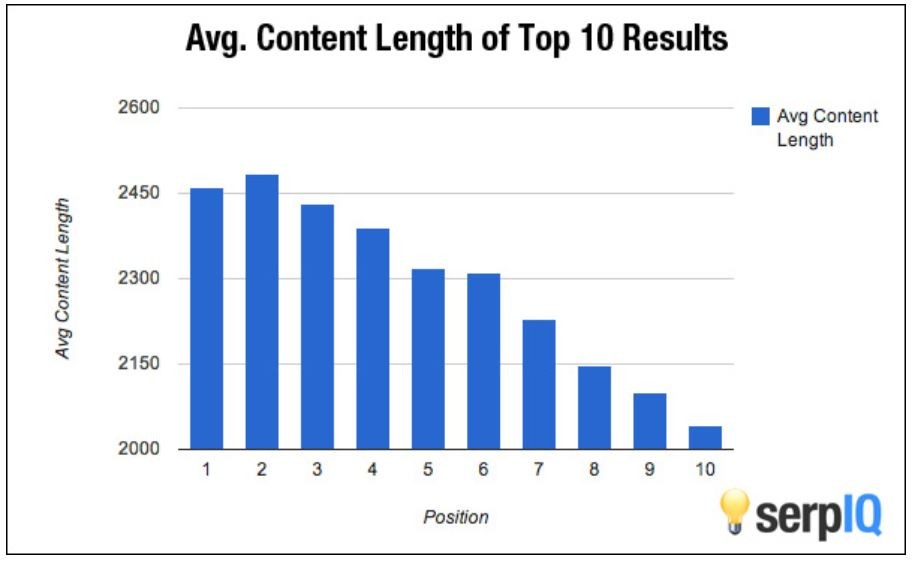
While this is true, it doesn't mean you should write thousands of words just to hit a word limit.
Content quality is always more important than quantity. If your content is good and is shared and linked, it can rank high on Google, even if there are other posts that are longer.
I prefer, Publish content in long form because it makes sense for SEO articles. That's what readers want and that's what my competitors are doing.
Tip: Just check how long the texts of the current Google top 10 competitors are for your target keyword - and write a little more than the average. Don't write significantly less, Google shows you with its top-10 selection how much content is expected. You will occasionally find very short texts, but often from extremely strong and authoritative websites. Unfortunately, these can afford it. If you are not one of the strongest sites in your niche, go the extra mile and accept your fate.
Optimize your long form content
A good tip for optimizing long-form articles is to use a Table of Contents at the beginning of the post to help users navigate through the content.
This not only makes navigation easier, but also increases the chance that sitelinks will be displayed together with your snippet in Google search results.
My SEMrush test for example, is 4000 words long because it covers all aspects of the tool. To help users navigate through the content, I have included a table of contents.
6. add internal links to other related content on your website
Another element of content SEO is the internal Link. Within your content, link to other pages on your site to help users learn more about a particular topic and give search engine crawlers another reason to index more pages on your site.
Internal links create the so-called "Content relevance", which helps Google to better understand the meaning of the content.
When you insert internal links, use meaningful Anchor textsso that the crawlers get a good idea of what the linked page is about.
TipInternal links show Google "look, I have a lot more great, topic-relevant content on my website. I'm an expert in my niche and constantly write great content. Please let me rank better, thank you"
5 tips for effective use of internal links:
- Use meaningful anchor textsInstead of general text such as "Click here" or "More information", you should use descriptive words or phrases that describe the page you are linking to. For example, "Learn more about our product range" instead of "Click here".
- Distribute the links evenly: Try to use some internal links on each page instead of concentrating them all on one page. This helps to ensure that all pages are well crawled and indexed be
- Link to important pages: Prioritize your most important pages, such as product pages, contact pages, and blog posts, and link to them from other pages on the site.
- Use breadcrumb navigation: Breadcrumb navigation helps you find your way around the site and understand where you are in relation to the site as a whole. There is also the advantage that search engines can recognize how pages are organized hierarchically.
- Use clickable images: Images can be a great way to place internal links on a page and draw the visitor's attention to a specific page. Make sure the images are clickable and link to relevant pages on the site.
7. add external links to other high quality websites
In addition to linking to your own articles, it is a good practice to link to other quality websites or sources when available:
- They help users learn more about a topic
- You trust the website you link to
- Don't go overboard with external links, but don't be afraid to link when it makes sense.
TipExternal links show Google that you write your content based on quality sources. When you link to studies or expert content from sites Google trusts, Google understands that you didn't make up your content and trusts you more.
5 tips for effective use of external links:
- Link only to trusted sources: Make sure you only link to sites that you deem trustworthy and that provide relevant information for your target audience.
- Use meaningful anchor text: Use descriptive words or phrases that describe the page you're linking to, rather than generic text like "click here" or "more information".
- Distribute links evenly: Distribute external links evenly throughout your site, rather than concentrating them all on one page.
- Link to supporting content: Link to supporting content such as studies, statistics, or expert opinions that strengthen your argument.
- Use "nofollow" attributes: If you're linking to pages you don't want to influence, use the "nofollow" attribute to tell search engines that this link won't help improve SEO.
8. make your SEO content easy to read
Make sure your content is easy to read. Don't just write text on a page, but apply formatting styles to make it easier to read, especially for users who like to skim.
- Use short Heelsbecause these do not slay the reader
- Use Listento structure steps clearly
- Use short phrases, no one likes to read legal texts and paragraphs
- Use a Font, which are easily readable on all devices (and large enough) is
- Add enough Blank space between your paragraphs a
- Use Headings and subheadings: By using headings and subheadings, you help readers quickly identify and navigate the key points of your post.
- Use boldface and italics: Use bold and italics to emphasize important words and draw the reader's attention to specific points.
- Add pictures and videos: Include images and videos to keep the reader's attention and make complex information easier to convey.
- Use simple verbiage: Use simple words and phrases that your audience can easily understand. It also helps to read the text more fluently and avoid comprehension problems.
- Use language that is easy to understand: Use language that is easy to understand and avoid jargon or abstract terms that may be difficult for the reader to understand.
9. optimize non-text elements
As I mentioned earlier, content can take many forms and doesn't have to be text. If you use other When inserting non-text elements into your content, make sure that they are optimized. The most common element are Imagesand all images in your content should:
- a meaningful, readable File name have (e.g. lsi-keywords.jpg and not 345afg.jpg)
- a matching ALT text have
- a Insert text line under the imagewhich describes what the picture is about.
10. combine related pages into categories
While this is not directly related to content SEO, it is good for your overall SEO.
When Google crawls a page, it is primarily interested in the content of that page, but it also takes into account where the page belongs.
In other words: You should Create categories and your pages into groups and make sure that the structure of your website is reflected in your menu and in the Breadcrumbs reflects.
Example:
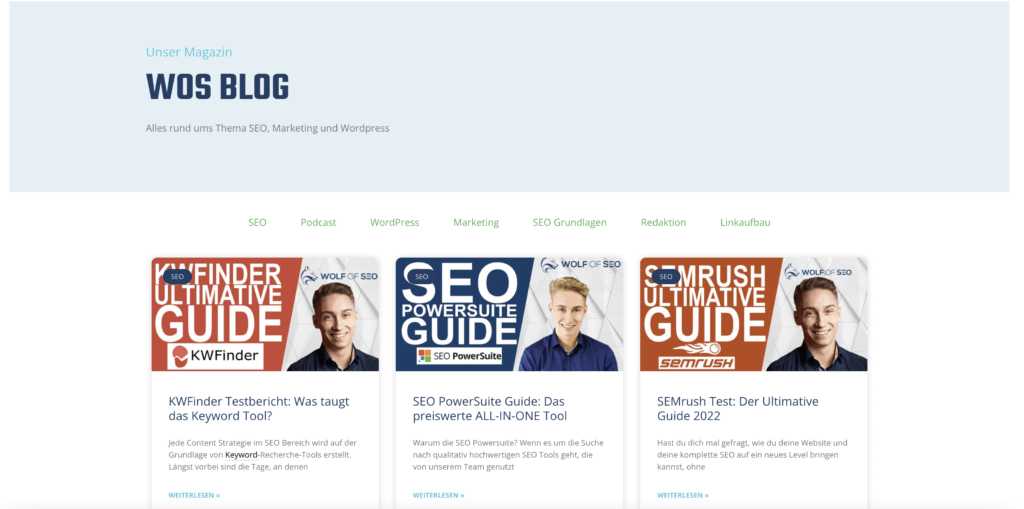
11. always offer users a CTA or exit point
I have already mentioned that the Main goal of content SEO is to fulfill the intention of the user. But just as important is meeting your goals as a company.
Every piece of content published on your website should have a purpose. With "Purpose" we mean: "What do you want users to do when they read your content?
Want more Gain email subscribers? Then make sure that under your posts you put a Login field have.
Do you want people to buy your products and services? Then make sure that in your content. CTA (Call to Action) to direct visitors to your sales pages.
Do you want your ads to be clicked? Then make sure the ads are visible while users are reading the content.
Do you want users to engage and stay on your site longer? Then add a related articles section below the post.
Whatever your goal, it should be clear to users what the next step is to continue their journey.
What does your SEO content strategy look like?
When you publish new content, you should follow the best practices mentioned above, but at the same time you also need a Content strategy.
What do we mean by a Content strategy? Have a plan that includes:
- Which Type of content you want to publish
- Which Keywords you want to conquer
- When you publish them
- Like is it advertised?
- For whom it is advertised (the target audience for each content)
When discussing content SEO, it's important to understand that it's not enough to optimize your existing content, you need to find a way to produce new content on a regular basis.
Competition is fierce and if you want to reach or overtake your competitors, you need to create a content marketing plan and follow it without excuses.
Consistently publishing high quality content is the best way to increase your Ranking on Google to improve.
Es ist außerdem erwiesen, dass Unternehmen, die regelmäßig bloggen, mehr Leads bekommen als solche, die das nicht tun.
Your ongoing SEO process should include the following:
- Ways to promote your content
- Strategies for the Link building
- Monitoring rankings for keywords and individual pages
- A content improvement plan (for existing posts).
Conclusion
Content SEO is a very important part of the On-page SEO-Process. Your overall goal is to, to provide both users and search engines with the content they are looking for. As Google said, you need to know what your readers want and give it to them.
The process begins with you find out, what users are looking for, and create content that fulfills their intentions.
Before you press the "Publish" button, you should make sure that your Main keywords in the upper part of the page and related Keywords (including LSI) in the Subheadings and in the Main part are included.
Beautify your content, make it easy to read and navigate and then publish them to be seen by as many people as possible.


